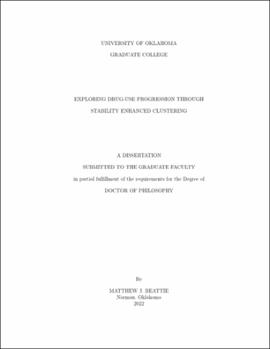| dc.contributor.advisor | Nicholson, Charles | |
| dc.contributor.author | Beattie, Matthew | |
| dc.date.accessioned | 2022-04-28T16:35:51Z | |
| dc.date.available | 2022-04-28T16:35:51Z | |
| dc.date.issued | 2022-05 | |
| dc.identifier.uri | https://hdl.handle.net/11244/335377 | |
| dc.description.abstract | Background and aims: Drug use initiation sequences have been the subject of
much research, and theories such as the Gateway Hypothesis have been created
to explain patterns of progression from common to dangerous drugs. This study
uses adult respondent observations from four years of the National Survey on Drug
Use and Health (NSDUH) to uncover complex patterns associated with the age
of rst use (AFU) of drugs that are di cult to discern using a priori hypothe-
ses. From these patterns, a classi cation study is conducted to determine what
AFUs for quasi-legal drugs are most associated with subsequent illicit drug use.
Associations of demographic features with the AFU patterns are explored as well.
Methods: A modi cation to K-means clustering (KMC) is developed to improve
the partition stability of survey data. This method, stability enhanced K-means
clustering (SEKMC), builds partitions that are based upon relationships among
observations that persist across multiple partitions of bootstrap samples of the
NSDUH data. The computational complexity of the method is overcome through
cluster computing and the development of an algorithm to calculate completely
connected components in a graph in O(V) time. Classi cation of illicit drug use
as a function of quasi-legal drug AFUs is conducted using decision trees and logis-
tic regression. Descriptive techniques, including a 2 analysis are applied to the
partitioned data to relate demographic features to AFU patterns. Findings: A
partition of the data is extracted that contains 13 clusters, including ones of note {
early age marijuana initiation, a set of clusters whose commonality is based upon
illicit drug use, and one that indicates a link between prescription drug abuse
and marijuana. Both the decision tree and logistic regression analyses demon-
strate a strong association between early AFU of marijuana and subsequent illicit
drug use. Non-Hispanic Asians are more likely than any other ethnicity to be-
long to a no-use cluster, and respondents with less than high school education are
paradoxically more likely to belong to both the no-use and polyabuse clusters. | en_US |
| dc.language | en_US | en_US |
| dc.rights | Attribution-NonCommercial-NoDerivatives 4.0 International | * |
| dc.rights.uri | https://creativecommons.org/licenses/by-nc-nd/4.0/ | * |
| dc.subject | machine learning | en_US |
| dc.subject | clustering | en_US |
| dc.subject | classification | en_US |
| dc.subject | drug use | en_US |
| dc.title | Exploring Drug-Use Progression Through Stability Enhanced Clustering | en_US |
| dc.contributor.committeeMember | Razzaghi, Talayeh | |
| dc.contributor.committeeMember | Song, Hairong | |
| dc.contributor.committeeMember | Shehab, Randa | |
| dc.date.manuscript | 2022-04 | |
| dc.thesis.degree | Ph.D. | en_US |
| ou.group | Gallogly College of Engineering | en_US |
| shareok.orcid | 0000-0001-7623-6894 | en_US |
| shareok.nativefileaccess | restricted | en_US |

